Author: Mr A
Location: Yulara & Uluru National Park
Monday: Riding The Rock!
Catherine had heard that you could now cycle around the rock – one of the many changes since climbing it has been finally banned.
We lost no time after setting up camp to throw the bikes on the back of the car and head into Uluru National Park. It’s only 20km away by road, but we wanted to avoid the testosterone fuelled drivers who are often behind the wheel of a big four wheel drive for the first time after a rental from Alice. Combine those folk with the foreign tourists who have forgotten which side of the road we drive on here (as we encountered driving into the park just as one was driving the wrong way down the park check-in road!)…No…a few minutes loading the bikes was worth it.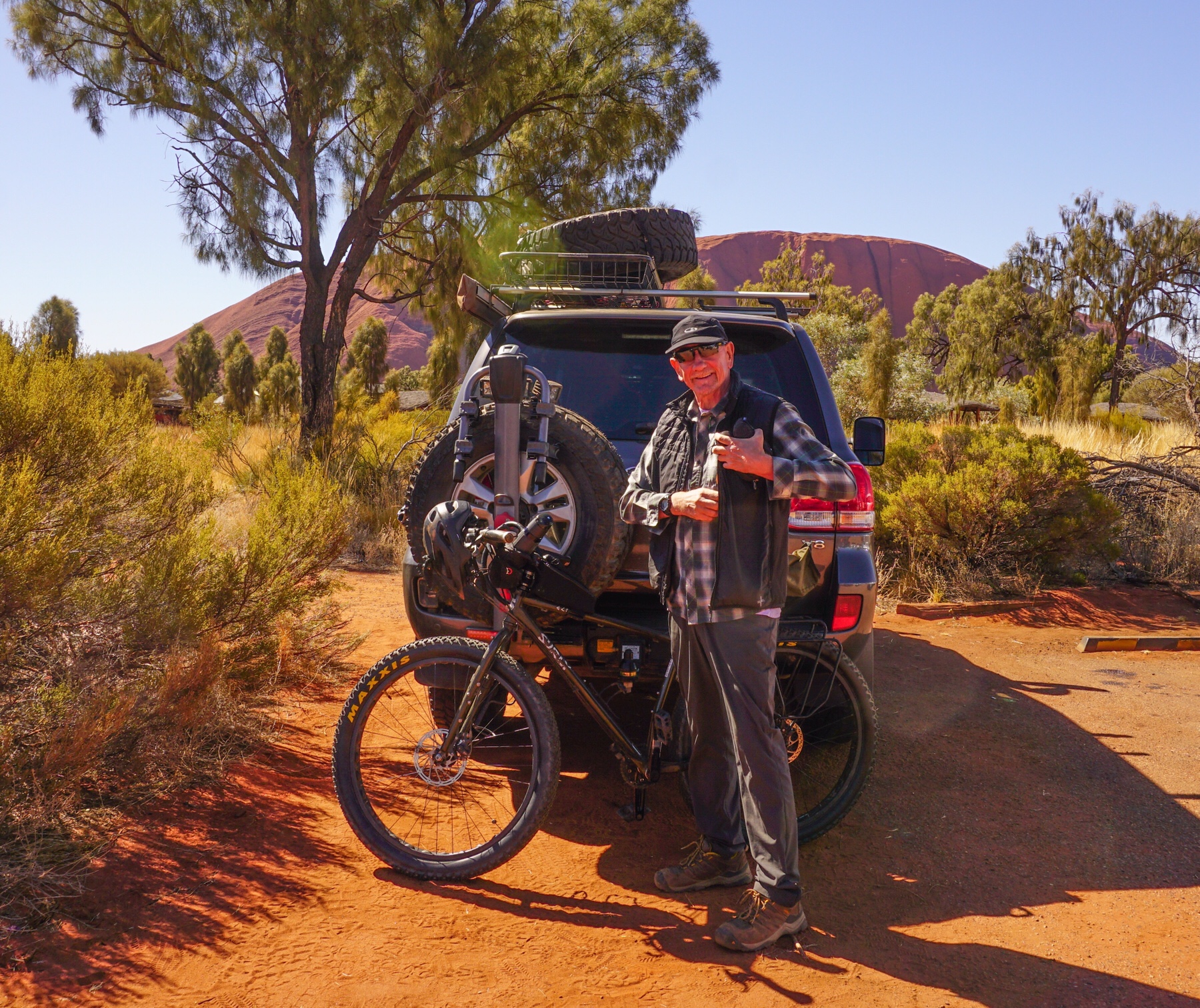 We left for our ride from the Cultural Centre and followed our noses as there were no signs for a cycling path, but there was this rather large rock to head for.
We left for our ride from the Cultural Centre and followed our noses as there were no signs for a cycling path, but there was this rather large rock to head for.
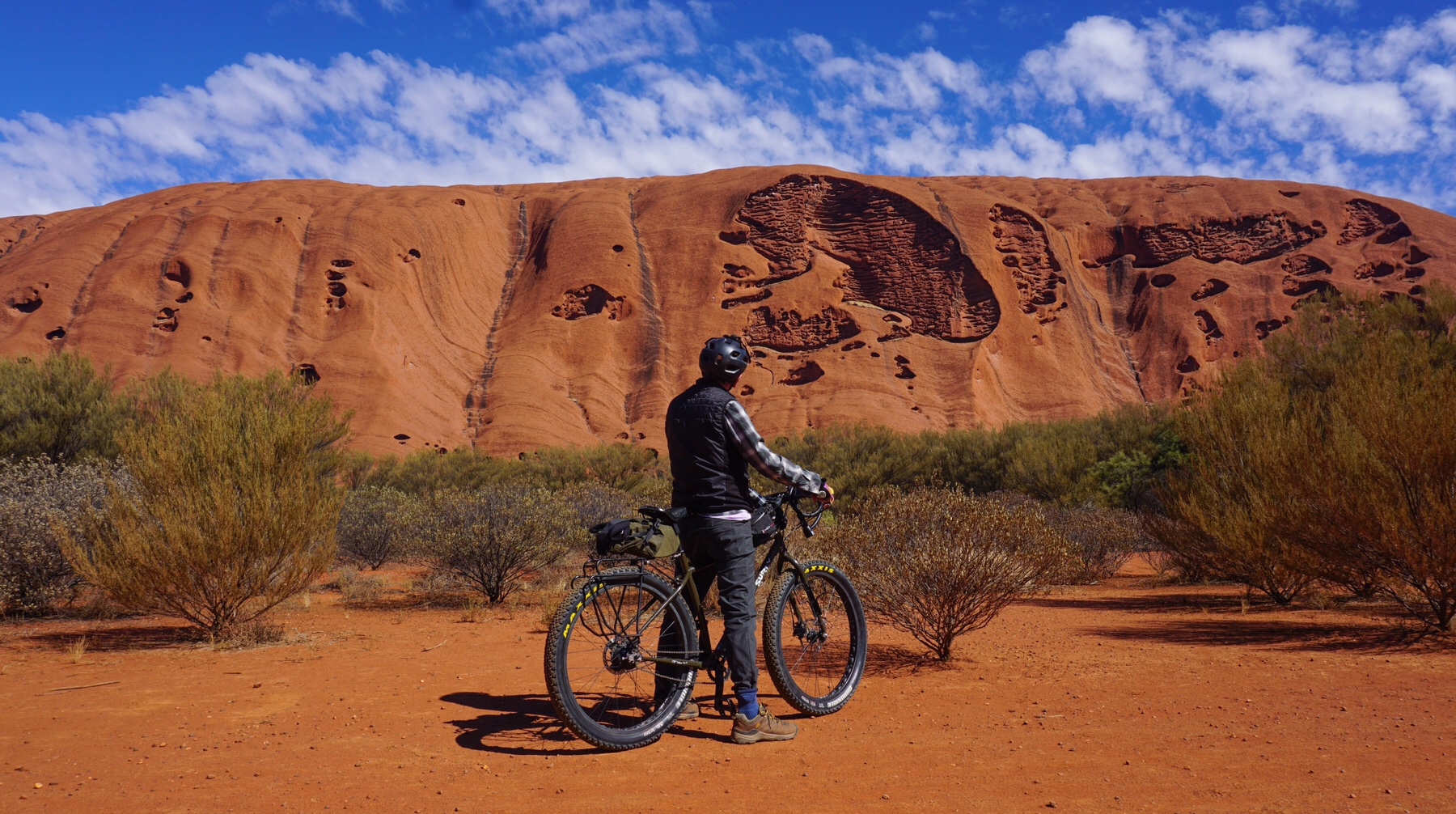
 We joined the pain path around the rock and checked the signage, it only showed walkers, but there were bike hire companies around and plenty of tyre marks, so off we went.
We joined the pain path around the rock and checked the signage, it only showed walkers, but there were bike hire companies around and plenty of tyre marks, so off we went.

 Riding a bike always brings a grin to our faces wherever we are, but to be riding along under this brilliant blue sky, dwarfed by this towering red rock…breathtaking. We just couldn’t stop ogling this magnificent scenery. Neither of us are in any way spiritual, but we both felt this to be the closest we could get, just sitting quietly looking up at this massive granite monolith towering over us.
Riding a bike always brings a grin to our faces wherever we are, but to be riding along under this brilliant blue sky, dwarfed by this towering red rock…breathtaking. We just couldn’t stop ogling this magnificent scenery. Neither of us are in any way spiritual, but we both felt this to be the closest we could get, just sitting quietly looking up at this massive granite monolith towering over us.
Miss Tassie also enjoyed the awesomeness of the Red Centre on an explore of the dunes near where we camped. When was the last time you saw a Burmese cat in front to Uluru, eh?
Tuesday: Visiting Kata Tjuta
A 45km drive in the morning, minus the caravan, took us to Kata Tjuta, which European explorers renamed The Olgas. This area contains an unusual geological formation of a series of large domed granite rocks, which in this crystal clear desert air, looks so spectacular against the almost perennially deep blue sky. The short walk we did here was one of the most enjoyable we have done from a scenic perspective for ages. It’s called the Valley of the Winds walk, and takes you up through the domes and in a 7km circuit.
The short walk we did here was one of the most enjoyable we have done from a scenic perspective for ages. It’s called the Valley of the Winds walk, and takes you up through the domes and in a 7km circuit.


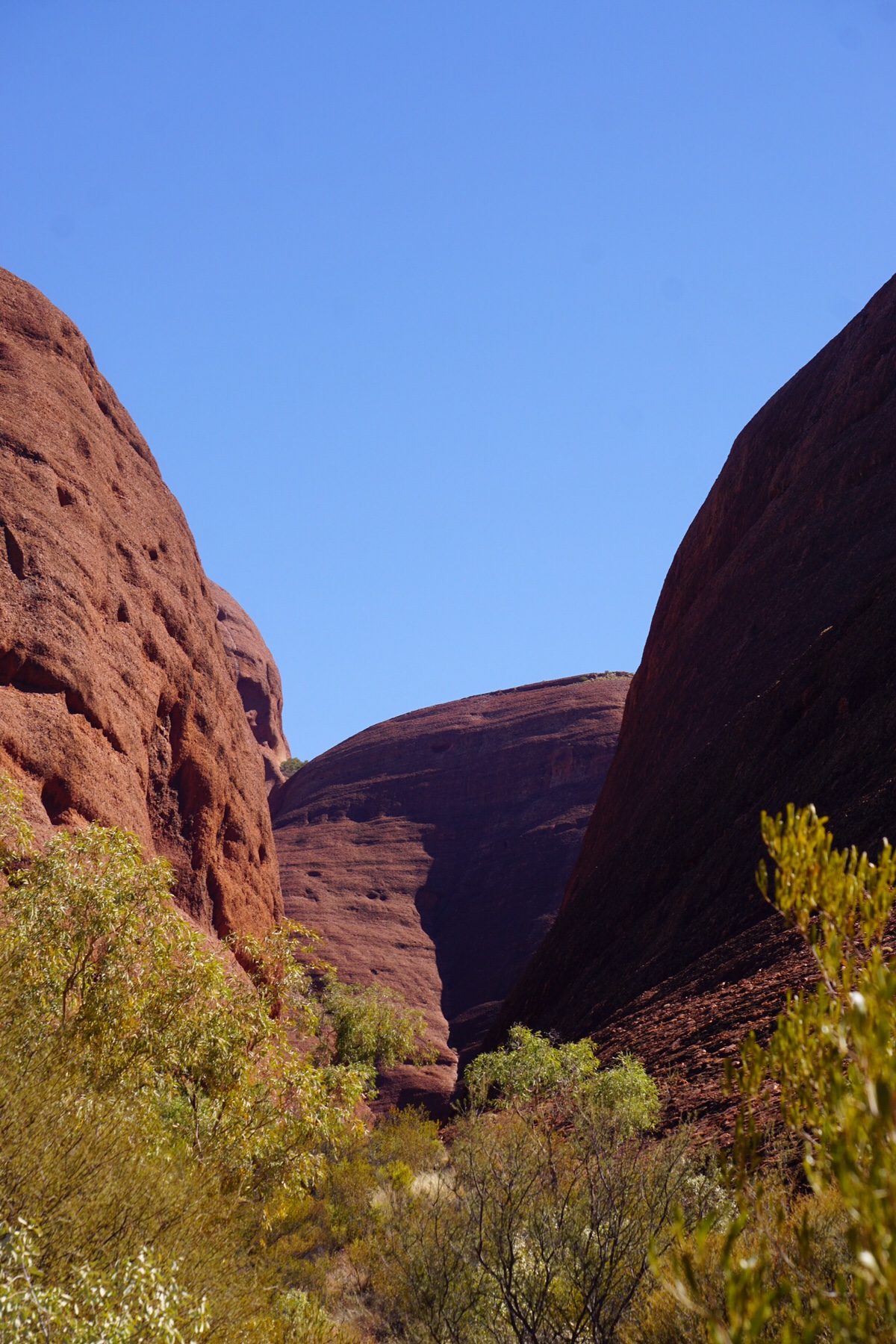
 (Below, a friendly Grey Shrike-Thrush which accompanied us on our walk)
(Below, a friendly Grey Shrike-Thrush which accompanied us on our walk) We could easily have spent a few more days here, but we are now on a bit of deadline, given we have lost a couple of weeks from our itinerary. So soon it was time to pack up and move on.
We could easily have spent a few more days here, but we are now on a bit of deadline, given we have lost a couple of weeks from our itinerary. So soon it was time to pack up and move on.


 Anyway, it was a long day in the saddle, but we pulled up finally at a place we had stopped at on the way north last year. It’s just an old road that loops off the Stuart Highway for about 5km, signposted ‘Churchill’s Head’.
Anyway, it was a long day in the saddle, but we pulled up finally at a place we had stopped at on the way north last year. It’s just an old road that loops off the Stuart Highway for about 5km, signposted ‘Churchill’s Head’.
 No facilities, just a level bit of ground a view across the plains. We loved it last time, and we love it again. There seem to be so few places like this on the well trodden routes we have been following. For a start there are very few minor roads that lead off the main highway, so we are drawn to caravan parks or the crowded free camps often so close the highway that the road trains sound like they are coming right through the Zone! “Ah..the serenity”, to quote from one of our favourite movies “The Castle”.
No facilities, just a level bit of ground a view across the plains. We loved it last time, and we love it again. There seem to be so few places like this on the well trodden routes we have been following. For a start there are very few minor roads that lead off the main highway, so we are drawn to caravan parks or the crowded free camps often so close the highway that the road trains sound like they are coming right through the Zone! “Ah..the serenity”, to quote from one of our favourite movies “The Castle”. If we were to walk out of the van due west we wouldn’t reach another tarmac road for 1,325km – on the west coast of Australia, south of Broome. Not one hint of civilisation, except the Alice to Darwin railway. Nothing else. What a country. How many places in the world still have that amount of emptiness?
If we were to walk out of the van due west we wouldn’t reach another tarmac road for 1,325km – on the west coast of Australia, south of Broome. Not one hint of civilisation, except the Alice to Darwin railway. Nothing else. What a country. How many places in the world still have that amount of emptiness?

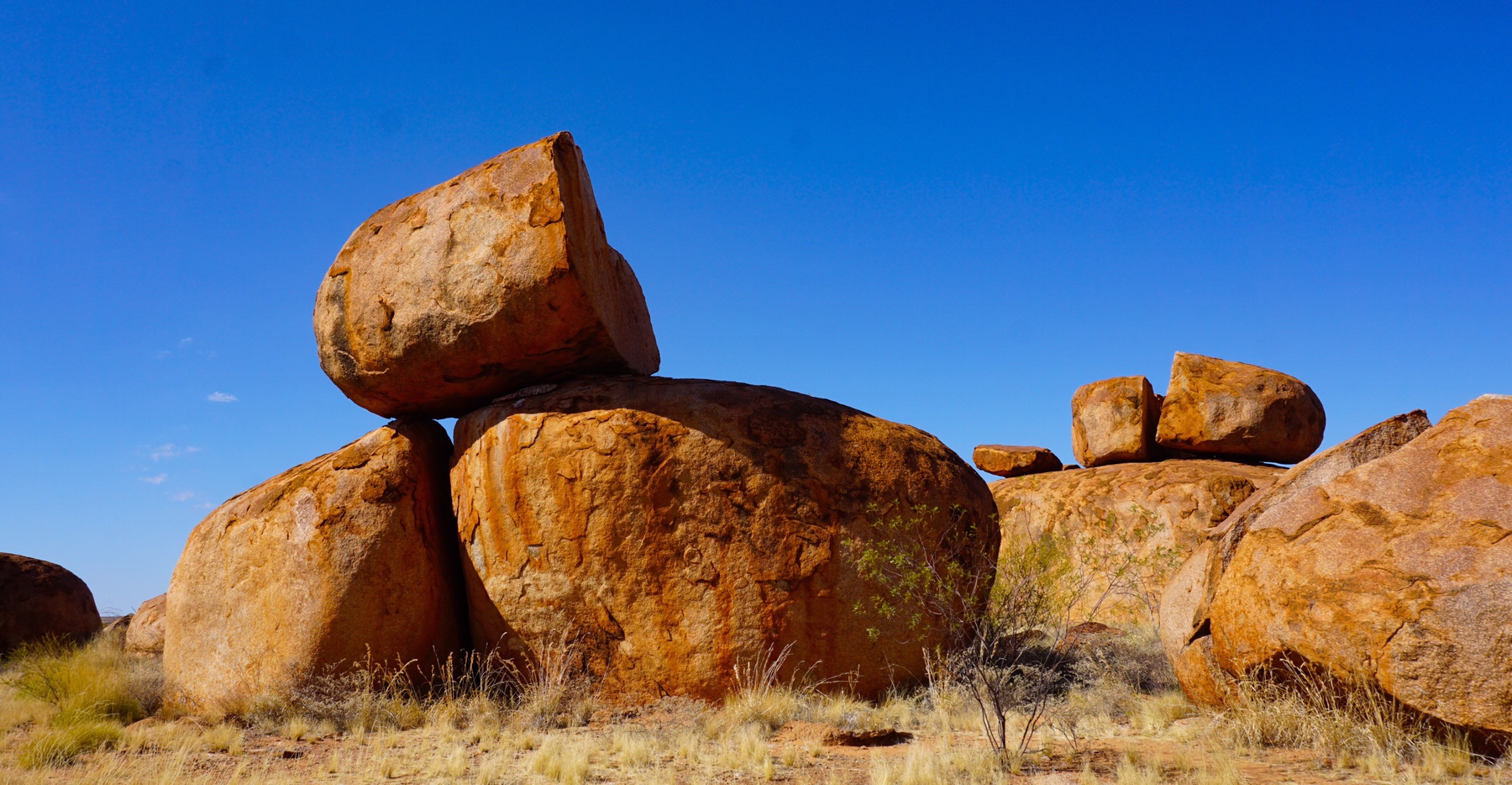


 Then after lunch we were through Tenant Creek, only stopping for the dump point, and by late afternoon arriving at our camp for the night in a small service centre for the surrounding aboriginal communities called Ti-Tree. Guess what sort of trees grow here?
Then after lunch we were through Tenant Creek, only stopping for the dump point, and by late afternoon arriving at our camp for the night in a small service centre for the surrounding aboriginal communities called Ti-Tree. Guess what sort of trees grow here?
 After the area was mined for zinc, silver and lead, the property was purchased by a French botanist who worked for the government. He spent his life planting an incredible botanical garden, irrigating his prize plants from the river, and recording the flora and fauna around the property in meticulous notes, only to have the whole lot burn down from a fire that escaped from a local mine. He no doubt cried “Merde” and promptly laid down in a deep depression and passed away.
After the area was mined for zinc, silver and lead, the property was purchased by a French botanist who worked for the government. He spent his life planting an incredible botanical garden, irrigating his prize plants from the river, and recording the flora and fauna around the property in meticulous notes, only to have the whole lot burn down from a fire that escaped from a local mine. He no doubt cried “Merde” and promptly laid down in a deep depression and passed away.
 I would definitely recommend not listening to the advice they give you to “come out here early”. By lunchtime we were on our own, and what a fantastic place this is. One of the most beautiful locations we have ever paddled in with absolutely prolific birdlife echoing across the gorge. Apparently there are freshwater crocodiles in here – we didn’t spot any but did hear at least one suspect splash as we travelled silently along.
I would definitely recommend not listening to the advice they give you to “come out here early”. By lunchtime we were on our own, and what a fantastic place this is. One of the most beautiful locations we have ever paddled in with absolutely prolific birdlife echoing across the gorge. Apparently there are freshwater crocodiles in here – we didn’t spot any but did hear at least one suspect splash as we travelled silently along. There’s one short portage, no problem for us in lightweight boats, then the second part of the paddle was even more spectacular. The archer fish were out in shoals, spitting water up at me (did I look like a fly?). Fly catchers darted around above the water doing a much better job of catching their prey.
There’s one short portage, no problem for us in lightweight boats, then the second part of the paddle was even more spectacular. The archer fish were out in shoals, spitting water up at me (did I look like a fly?). Fly catchers darted around above the water doing a much better job of catching their prey.

 On the way back to the car we stopped at the information boards and read about the significant aboriginal history of the area. The gorge and surrounding area has been lived in for 35,000 years, according to the latest radiocarbon dating of artefacts found here. Not for the 200 years as you would think just reading the information back at Adels Grove. Just think on that for a moment. A continuous, sustainable, culture in this area stretching back 32,000 years before the Pyramids were being built. Nowhere else in the world has anything like that.
On the way back to the car we stopped at the information boards and read about the significant aboriginal history of the area. The gorge and surrounding area has been lived in for 35,000 years, according to the latest radiocarbon dating of artefacts found here. Not for the 200 years as you would think just reading the information back at Adels Grove. Just think on that for a moment. A continuous, sustainable, culture in this area stretching back 32,000 years before the Pyramids were being built. Nowhere else in the world has anything like that. After a 4 year hiatus, it has just restarted to the relief of the town, courtesy of a Chinese company (of course!). The gravity fed pipeline that transport the slurry stretches from the mine 302km to the south, right to the loading dock. Pretty neat and cheap way to transport it for 9 cents a ton!
After a 4 year hiatus, it has just restarted to the relief of the town, courtesy of a Chinese company (of course!). The gravity fed pipeline that transport the slurry stretches from the mine 302km to the south, right to the loading dock. Pretty neat and cheap way to transport it for 9 cents a ton!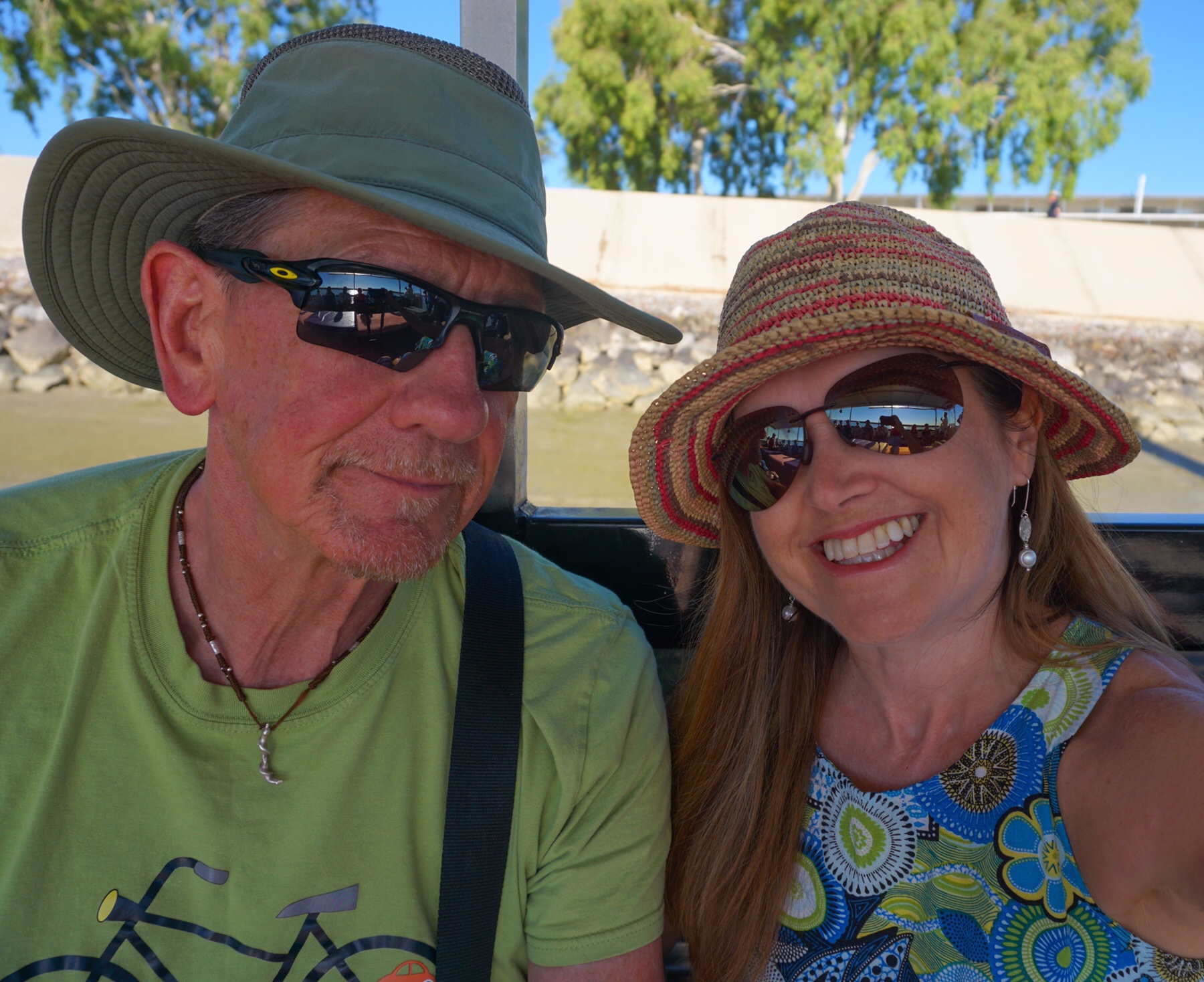 We managed to find a tour boat going out in the afternoon with two spaces (it’s busy season up here!) and headed out. The family running the trip gave us a good running commentary on the river and the town, of course starting as most trips do with “European exploration”, not a word about the previous 50,000 or so years of human occupation in the area. It isn’t easy to find information. I’ve just spent 20 mins with Google and have at least established that the area was home to five distinct Aboriginal groups, all of whom had a seperate language, all of which are now officially classed as extinct.
We managed to find a tour boat going out in the afternoon with two spaces (it’s busy season up here!) and headed out. The family running the trip gave us a good running commentary on the river and the town, of course starting as most trips do with “European exploration”, not a word about the previous 50,000 or so years of human occupation in the area. It isn’t easy to find information. I’ve just spent 20 mins with Google and have at least established that the area was home to five distinct Aboriginal groups, all of whom had a seperate language, all of which are now officially classed as extinct.





 Drinks were passed around as we watched the sun dip into the Gulf. At this moment the nearest capital city to us is Port Moresby in Papua New Guinea, not Darwin.
Drinks were passed around as we watched the sun dip into the Gulf. At this moment the nearest capital city to us is Port Moresby in Papua New Guinea, not Darwin.



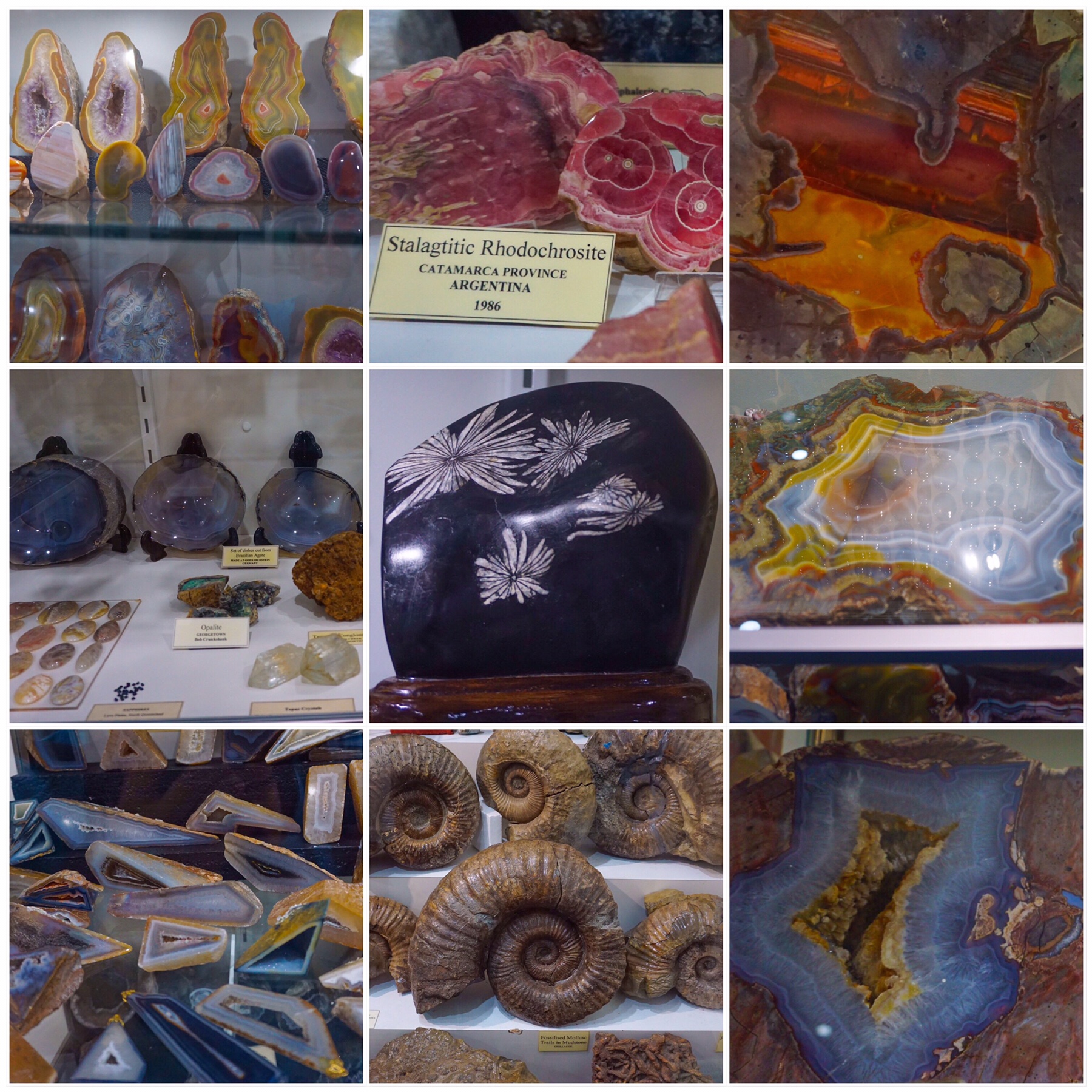 On from there we cycled to the only tourist activity we could see in the town itself, a 6km walk/ride along the outskirts of town.
On from there we cycled to the only tourist activity we could see in the town itself, a 6km walk/ride along the outskirts of town.
 We mostly followed the dry river bed, and all was going well, until that dreaded exclamation from Mrs A “Oh no….puncture”.
We mostly followed the dry river bed, and all was going well, until that dreaded exclamation from Mrs A “Oh no….puncture”. I nipped back to camp on my bike, and returned with the car. Mrs A was soon loaded up with her bike and returned to camp, where we spent the next 3 hours picking bindi spikes out of both of our tyres! I’ve never ridden in this type of country before, so was pretty shocked how it has destroyed even my thick tyres. At least my tubeless set up kept me inflated, well until I started picking out the thorns! We are now going to have the petite (but usually very reliable) MTB that Catherine rides converted to a tubeless set up as well. Definitely worth it. So no more riding until we get to Darwin in a couple of weeks.
I nipped back to camp on my bike, and returned with the car. Mrs A was soon loaded up with her bike and returned to camp, where we spent the next 3 hours picking bindi spikes out of both of our tyres! I’ve never ridden in this type of country before, so was pretty shocked how it has destroyed even my thick tyres. At least my tubeless set up kept me inflated, well until I started picking out the thorns! We are now going to have the petite (but usually very reliable) MTB that Catherine rides converted to a tubeless set up as well. Definitely worth it. So no more riding until we get to Darwin in a couple of weeks.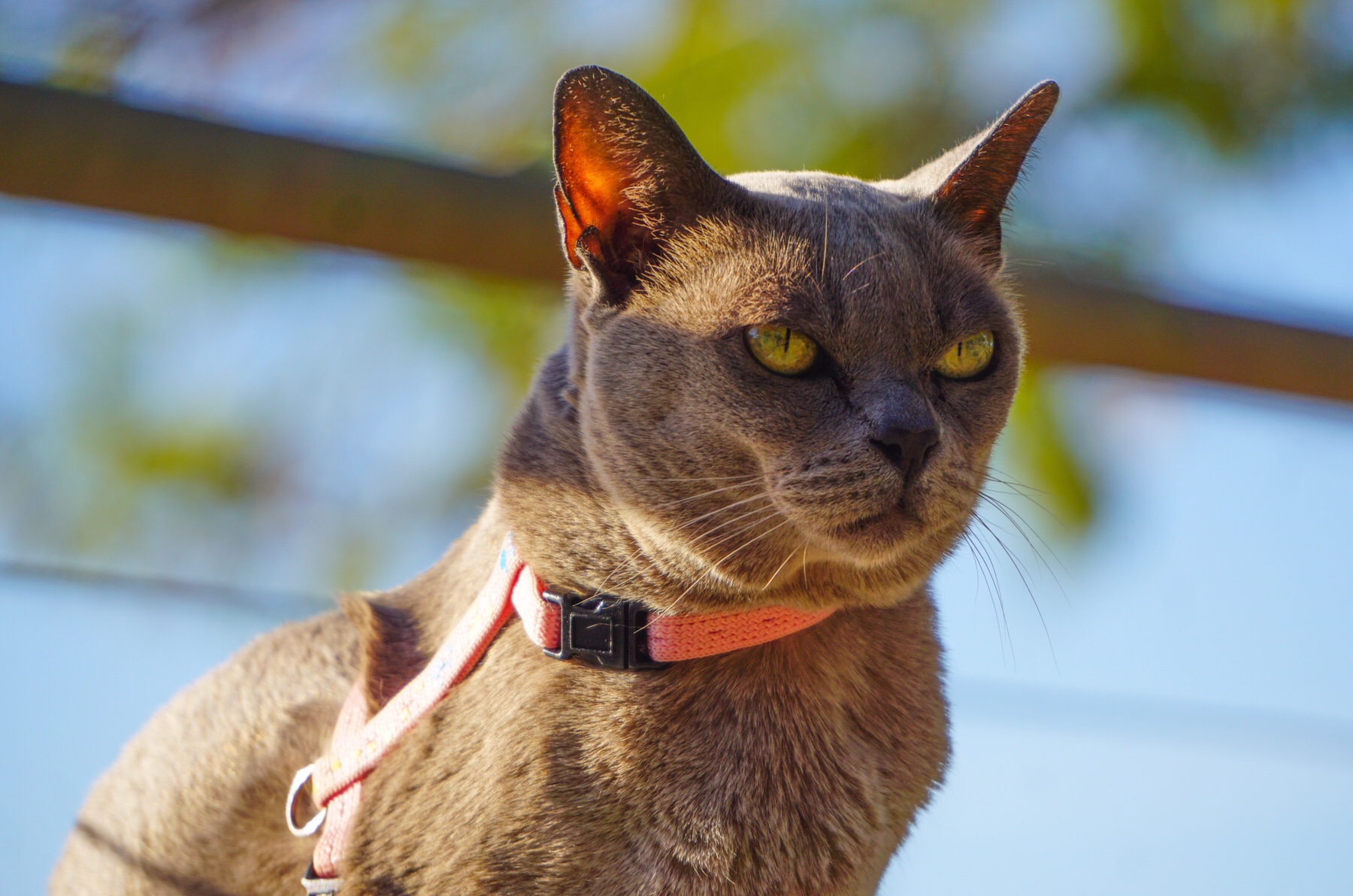 At least we have good phone signal here in tiny little Georgetown. It’s been an experience, and makes you realise from talking to the locals, what are some of the challenges of living in a remote area. No doctors, dentists, supermarkets (one of the petrol stations stocks some basic supplies). Or any other trappings we take for granted in the city – restaurants, hairdressers, clothes shops etc. And even this place isn’t remote by some Australian standards, ie. it has tarmac road access!
At least we have good phone signal here in tiny little Georgetown. It’s been an experience, and makes you realise from talking to the locals, what are some of the challenges of living in a remote area. No doctors, dentists, supermarkets (one of the petrol stations stocks some basic supplies). Or any other trappings we take for granted in the city – restaurants, hairdressers, clothes shops etc. And even this place isn’t remote by some Australian standards, ie. it has tarmac road access!
 I have to say I have become a fan of Flight Centre today. I booked through them and they have provided superlative service, so easy to get hold of a real person and talk to them. As compared to going through Qantas, where I spent 45mins on hold trying to even speak to their call centre to resolve an issue. And Flight centre were cheaper for the same tickets. Excellent.
I have to say I have become a fan of Flight Centre today. I booked through them and they have provided superlative service, so easy to get hold of a real person and talk to them. As compared to going through Qantas, where I spent 45mins on hold trying to even speak to their call centre to resolve an issue. And Flight centre were cheaper for the same tickets. Excellent. Undara is Aboriginal for ‘long way’, and is the name given to Undara Volcanic National Park when it was established in 1993. It’s interesting they chose to give it an Aboriginal name, since there is no evidence of any Aboriginal habitation, visitation or use in the direct vicinity. Still, I’m pleased there some nod of acknowledgement to the traditional custodians of this land, who suffered great losses at the hands of the original settlers.
Undara is Aboriginal for ‘long way’, and is the name given to Undara Volcanic National Park when it was established in 1993. It’s interesting they chose to give it an Aboriginal name, since there is no evidence of any Aboriginal habitation, visitation or use in the direct vicinity. Still, I’m pleased there some nod of acknowledgement to the traditional custodians of this land, who suffered great losses at the hands of the original settlers. The sun soon came out and the dry landscape lit up with the coppery tones of the iron filled granite contrasting with the jet black basalt. It’s all quite different to the rich and green landscape of the past few weeks and we are really noticing the impact of the rain shadow cast by the Great Dividing Range along the coast.
The sun soon came out and the dry landscape lit up with the coppery tones of the iron filled granite contrasting with the jet black basalt. It’s all quite different to the rich and green landscape of the past few weeks and we are really noticing the impact of the rain shadow cast by the Great Dividing Range along the coast. 
 Before long, we were entering the first tube, clambering down piles of rubble left from a roof collapse. We were all too aware of the many tons of basalt over our heads, held together by little other than the compressive strength of the arch. Should the keystone break, then our travels would have ended right here.
Before long, we were entering the first tube, clambering down piles of rubble left from a roof collapse. We were all too aware of the many tons of basalt over our heads, held together by little other than the compressive strength of the arch. Should the keystone break, then our travels would have ended right here. Fortunately for us, today was not that day, and we lived to explore another tunnel, this one around 1.3km in length, winding its way along an old watercourse. Bats, moths, cockroaches and cane toads are among the known (and seen) residents of these tunnels, and the colours are fabulous.
Fortunately for us, today was not that day, and we lived to explore another tunnel, this one around 1.3km in length, winding its way along an old watercourse. Bats, moths, cockroaches and cane toads are among the known (and seen) residents of these tunnels, and the colours are fabulous. Memories of my Uni Geography degree came back in troves, with images from text books flashing through my head, not revisited for more than 25 years! We both really enjoyed the visit – yes, it was pricey at nearly $60 a head for two hours, but we felt well educated at the end of it and further immersed in some of the geological history of Australia.
Memories of my Uni Geography degree came back in troves, with images from text books flashing through my head, not revisited for more than 25 years! We both really enjoyed the visit – yes, it was pricey at nearly $60 a head for two hours, but we felt well educated at the end of it and further immersed in some of the geological history of Australia. We decided to go for a stroll and what did we see? None other than a couple of handsome male cats on leads exploring. See folks – it’s not just us!
We decided to go for a stroll and what did we see? None other than a couple of handsome male cats on leads exploring. See folks – it’s not just us!
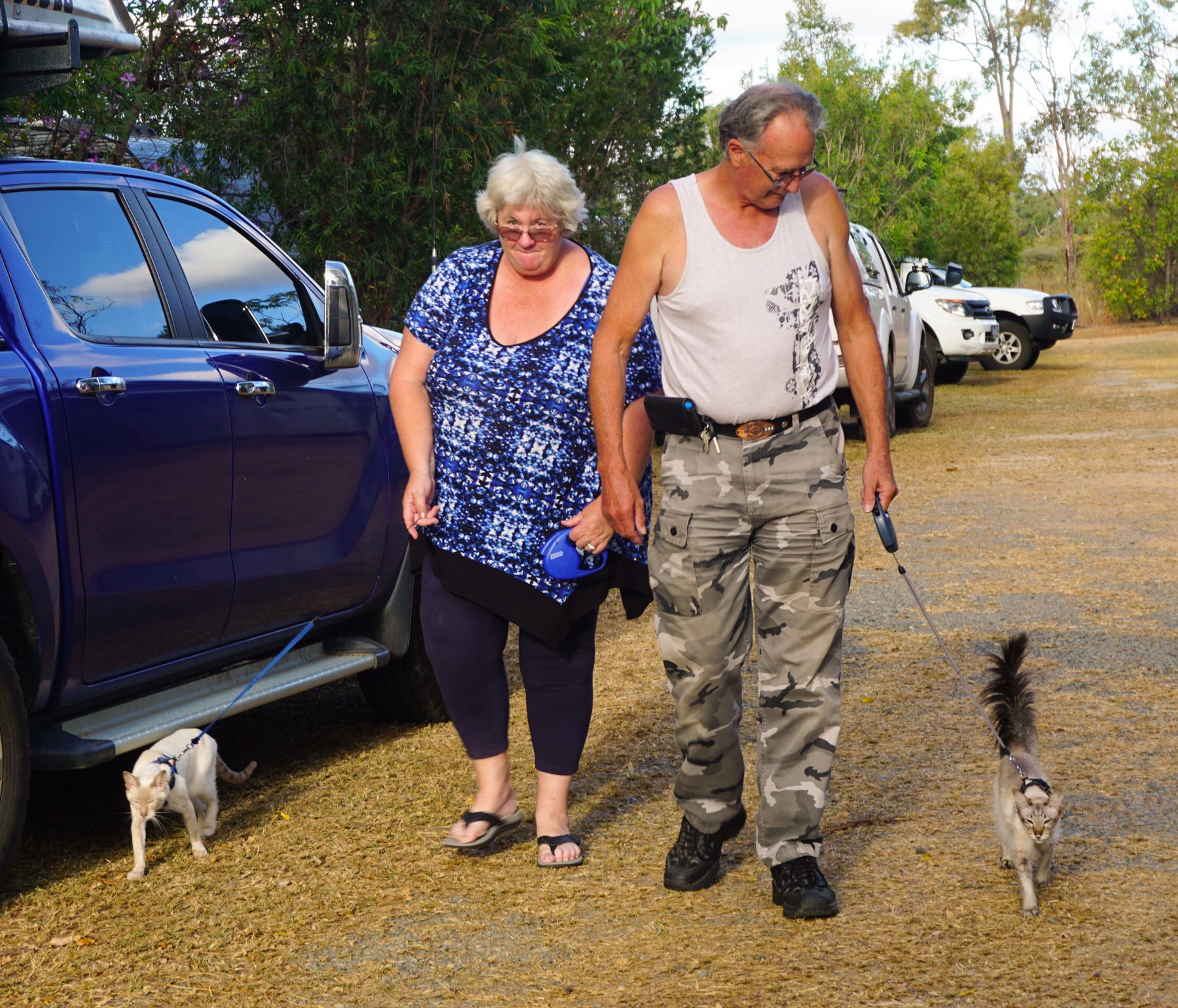 We continued our walk as the sun lowered in the sky, spotting birds and just enjoying the feeling of sun on our skin. As nostalgic as the rain and drizzle has made us feel, we really do appreciate the warmer weather!
We continued our walk as the sun lowered in the sky, spotting birds and just enjoying the feeling of sun on our skin. As nostalgic as the rain and drizzle has made us feel, we really do appreciate the warmer weather! Common Crow Butterflies, red winged parrots, whistling kites – there’s plenty of wildlife to be seen here, and topped our day off nicely.
Common Crow Butterflies, red winged parrots, whistling kites – there’s plenty of wildlife to be seen here, and topped our day off nicely.
 Where are we on our Savannah Way journey? Just a short way along, but a world of difference from Cairns. Off to a new destination tomorrow and a whole lot more red dust!
Where are we on our Savannah Way journey? Just a short way along, but a world of difference from Cairns. Off to a new destination tomorrow and a whole lot more red dust! The Savannah Way
The Savannah Way
 Mrs A managed to score some lovely earrings and a necklace made by three local jewellers, and two dresses beautifully modelled here.
Mrs A managed to score some lovely earrings and a necklace made by three local jewellers, and two dresses beautifully modelled here.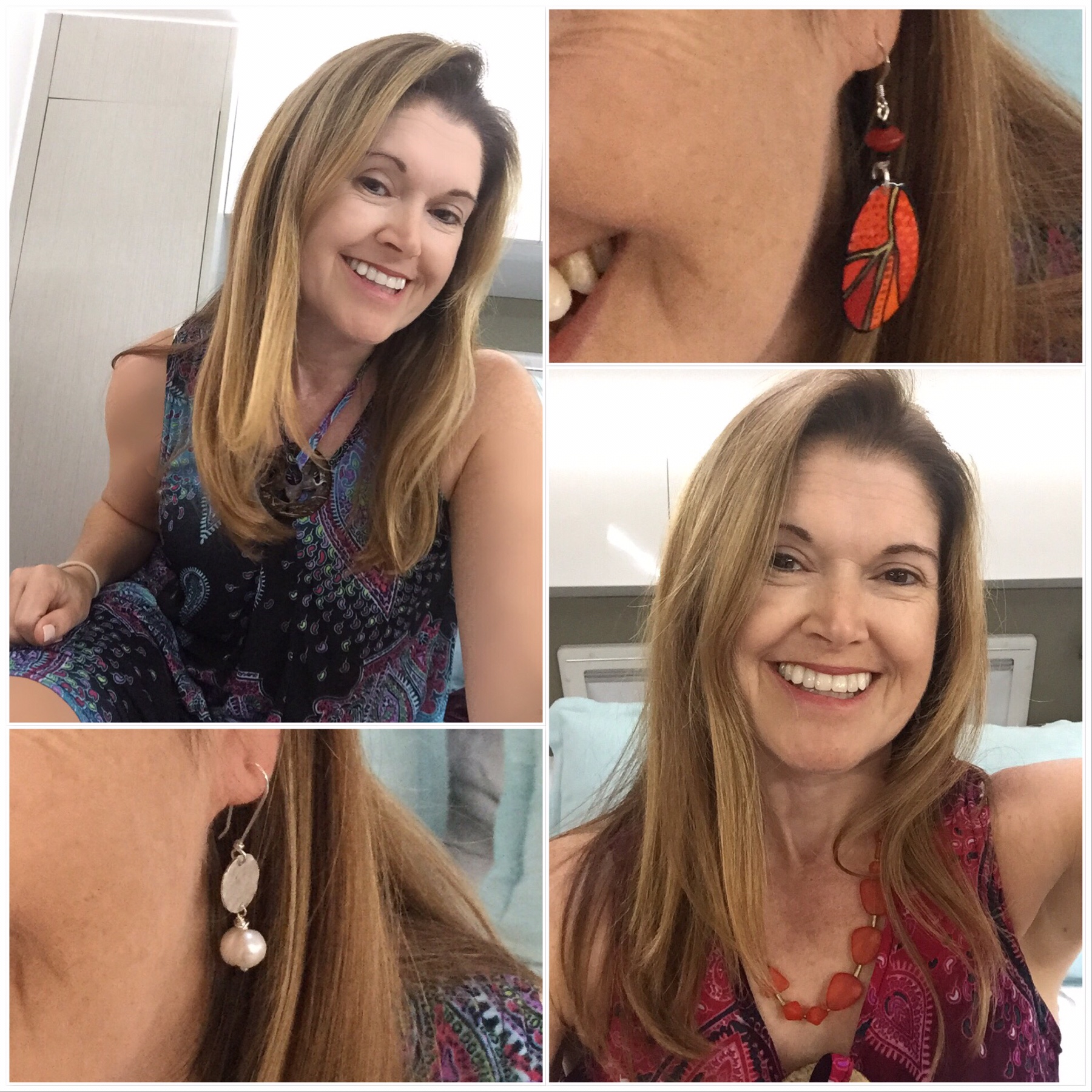 It was with a good degree of excitement that we hitched up and said goodbye to the Coral Sea as the next ocean we are likely to see is the Timor Sea, up in the Gulf.
It was with a good degree of excitement that we hitched up and said goodbye to the Coral Sea as the next ocean we are likely to see is the Timor Sea, up in the Gulf. We called back in to our favourite store on the tablelands, the Humpy, for some last minute fruit, vegetables and other local treats, before deciding to press on to a place called Pinnarendi Station. This is another working farm that is making some money from the passing caravans by offering sites with power, water and even meals. Good on them. It’s great to see so many people having a go at something new, seeing an opportunity and investing in some basic facilities for travellers.
We called back in to our favourite store on the tablelands, the Humpy, for some last minute fruit, vegetables and other local treats, before deciding to press on to a place called Pinnarendi Station. This is another working farm that is making some money from the passing caravans by offering sites with power, water and even meals. Good on them. It’s great to see so many people having a go at something new, seeing an opportunity and investing in some basic facilities for travellers. If only the clouds had lifted, which they did when we had finished, it would have been great views across the range.
If only the clouds had lifted, which they did when we had finished, it would have been great views across the range.

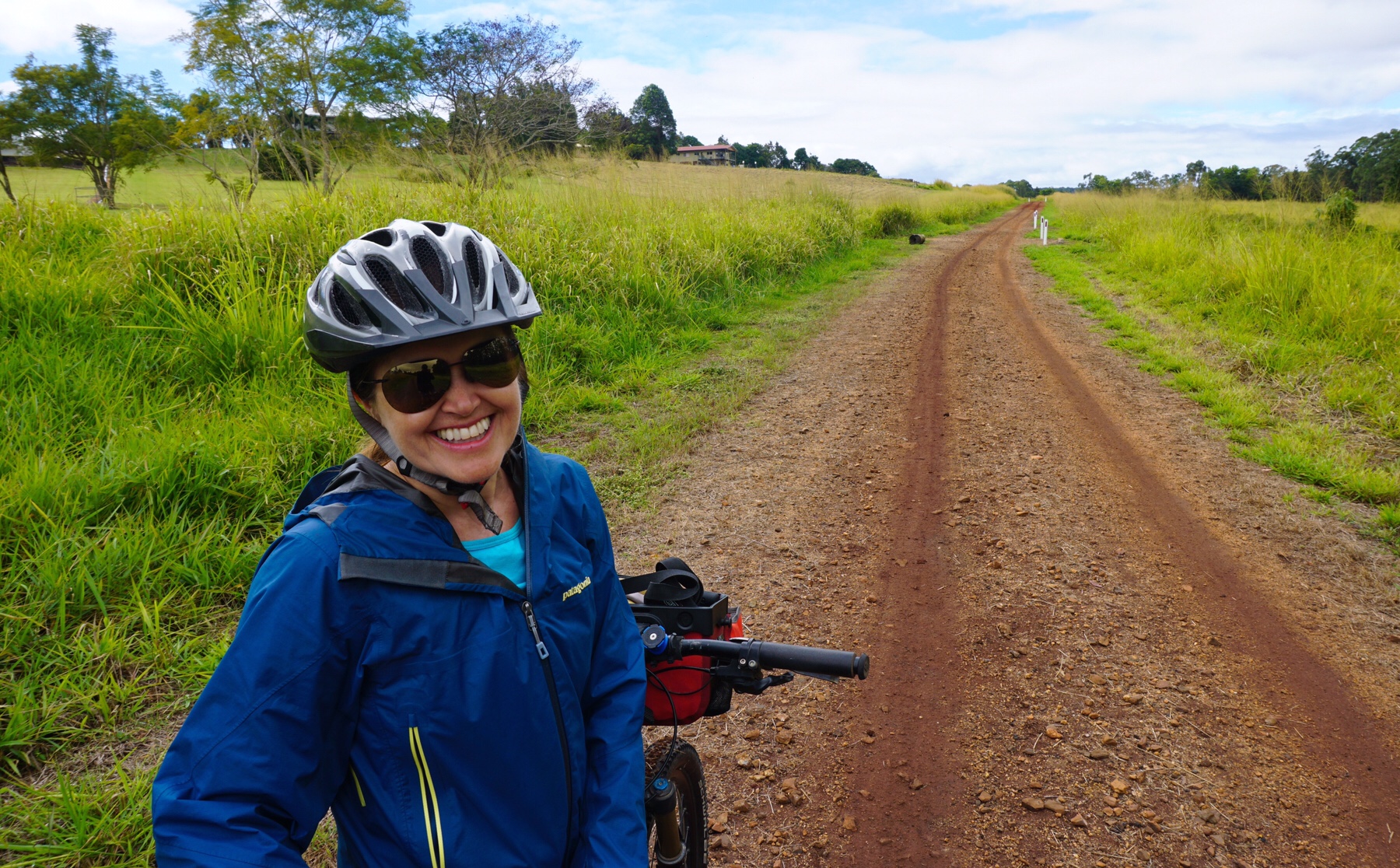 It was actually a great ride initially through a countryside of rolling hills, then we headed round a loop on some tarmac and back to base via a series of local mountain bike trails through the rainforest, ticking off just over 35km.
It was actually a great ride initially through a countryside of rolling hills, then we headed round a loop on some tarmac and back to base via a series of local mountain bike trails through the rainforest, ticking off just over 35km.
 A curry was called for after all that exertion, so our fellow Zoner Ken drove us into Atherton and we we finished our stay here with a great feed. We have really enjoyed the tablelands, apart from the weather, but tomorrow its time to head back down to the coast.
A curry was called for after all that exertion, so our fellow Zoner Ken drove us into Atherton and we we finished our stay here with a great feed. We have really enjoyed the tablelands, apart from the weather, but tomorrow its time to head back down to the coast. Willie started to take us on a tour of his “backyard”, where his grandfather’s bones are buried and where he was birthed. He explained what they ate and drank, plucking plants and fruit for us to smell and feel, and talked about the seasonal migrations from the bush to the beach, at pains to point out they were not nomads but followed a set path of migration along the songlines.
Willie started to take us on a tour of his “backyard”, where his grandfather’s bones are buried and where he was birthed. He explained what they ate and drank, plucking plants and fruit for us to smell and feel, and talked about the seasonal migrations from the bush to the beach, at pains to point out they were not nomads but followed a set path of migration along the songlines. The knowledge of flora and fauna these people have accumulated over 40,000 years and passed on through stories, music and art is just incredible. He had Catherine mix up some seeds in her hand that are used to put a protective coating over a wound, while he had another lady rubbing together some leaves from the soap bush creating a cleaning compound that was antiseptic.
The knowledge of flora and fauna these people have accumulated over 40,000 years and passed on through stories, music and art is just incredible. He had Catherine mix up some seeds in her hand that are used to put a protective coating over a wound, while he had another lady rubbing together some leaves from the soap bush creating a cleaning compound that was antiseptic.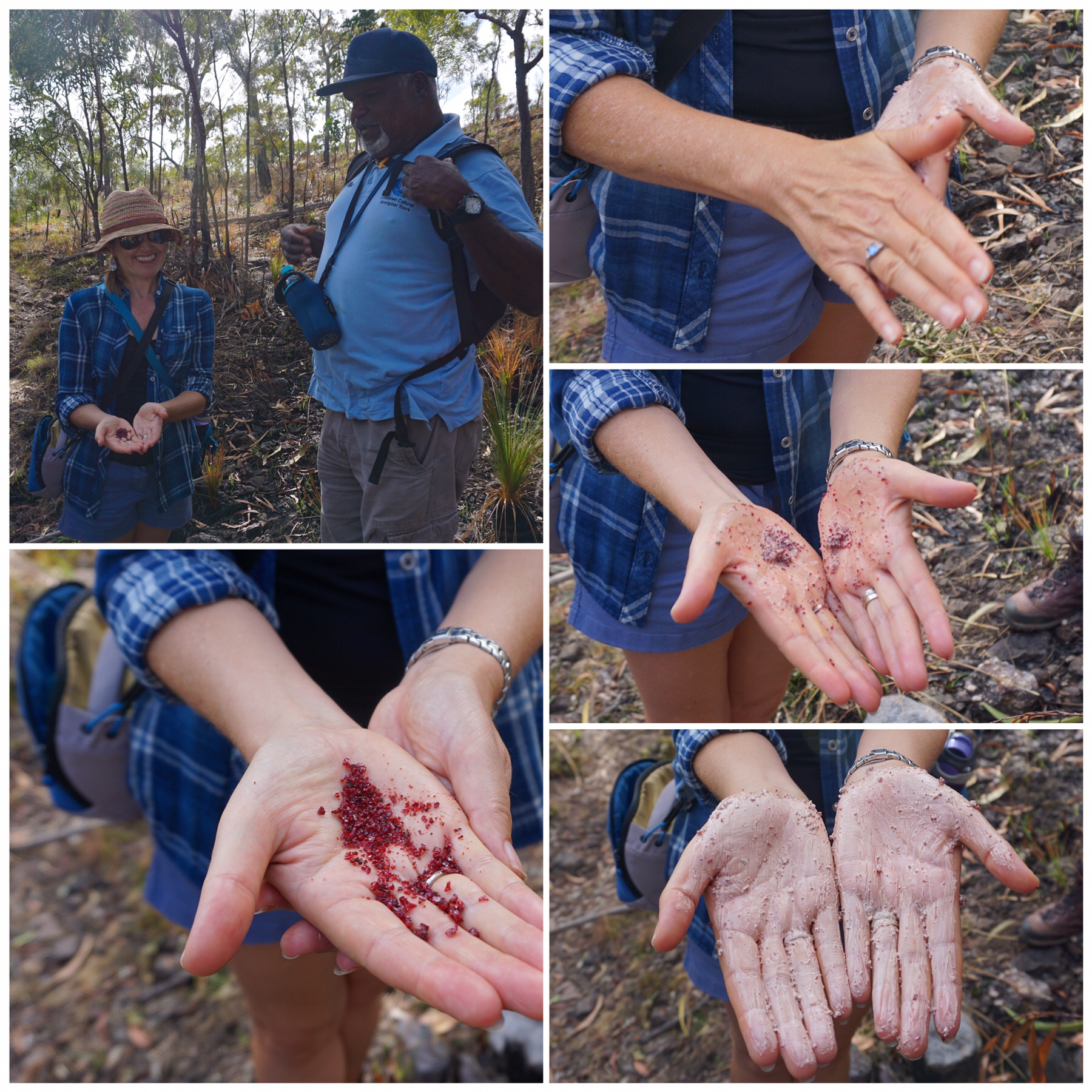
 We were led to a birthing cave and Willie explained the symbolism of some of the drawings, how they were painted and why. A big question the community is discussing is wether the drawings should be renewed, as they fade after a couple of thousand years. A couple of thousand! Incredible..these timeframes are mind boggling.
We were led to a birthing cave and Willie explained the symbolism of some of the drawings, how they were painted and why. A big question the community is discussing is wether the drawings should be renewed, as they fade after a couple of thousand years. A couple of thousand! Incredible..these timeframes are mind boggling.

 Catherine and I tried to take in as much as we could, but it was like walking into a library and having a teacher open a couple of books at random and read a few lines. We knew it was but a fleeting glance into a world we will never fully understand, but certainly appreciate and respect now even more what a trove of wisdom is there.
Catherine and I tried to take in as much as we could, but it was like walking into a library and having a teacher open a couple of books at random and read a few lines. We knew it was but a fleeting glance into a world we will never fully understand, but certainly appreciate and respect now even more what a trove of wisdom is there.
 If you come this way, support these efforts to help us all better understand and respect aboriginal culture. Willie Gordon can be found at Cooktown Cultural Aboriginal Tours – the information centre knows where to find him or indeed others like him.
If you come this way, support these efforts to help us all better understand and respect aboriginal culture. Willie Gordon can be found at Cooktown Cultural Aboriginal Tours – the information centre knows where to find him or indeed others like him.
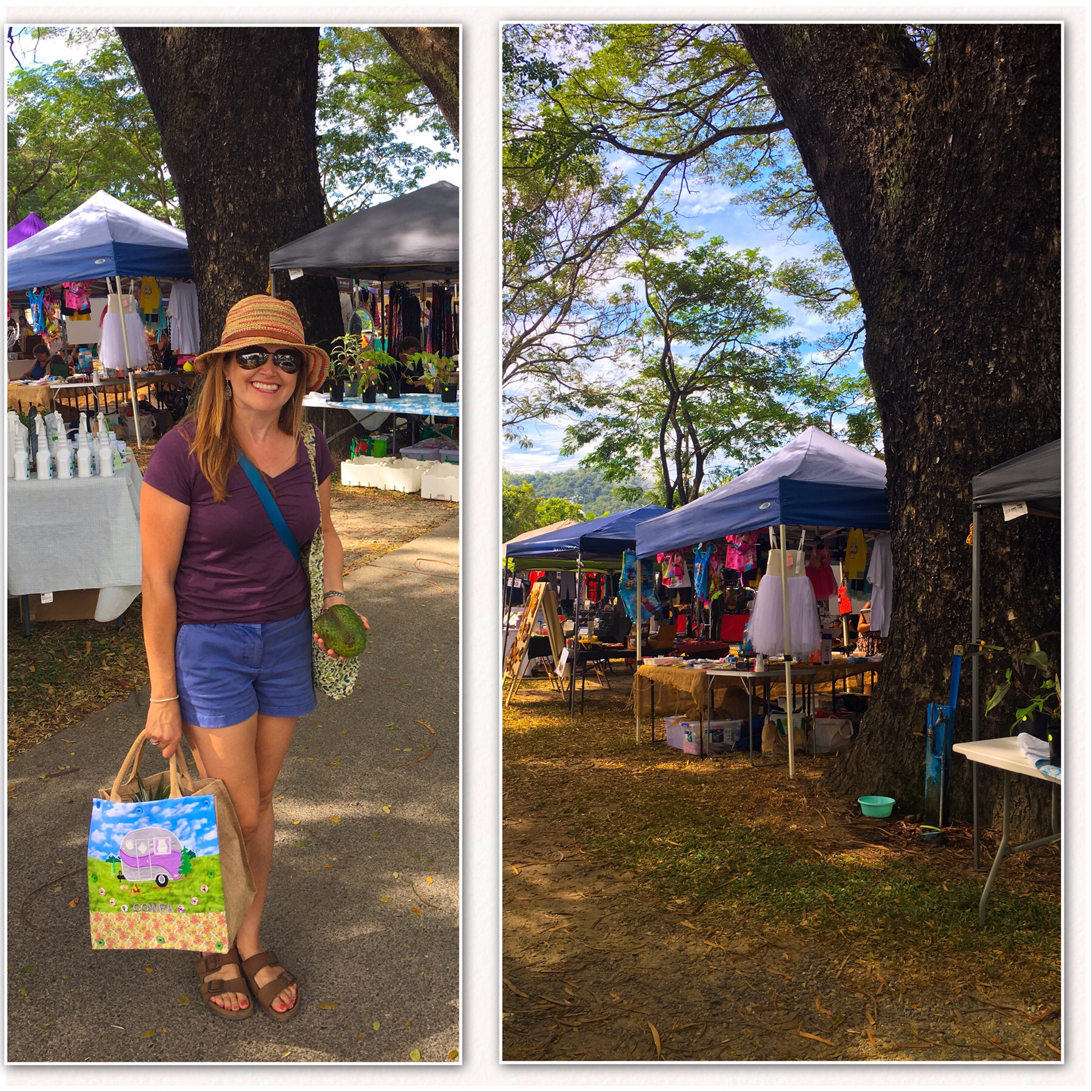 We finished up with a whole range of other fresh locally grown fruit and veg, so with our fridge crammed to capacity, we then turned off the coast road we had followed for so long and headed inland, up onto the north end of the Atherton Tablelands. We watched the scenery change dramatically as we climbed up the range, the Cruiser doing its usual impeccable job of dragging the 3 tons of loaded up Zone up the steep climb. Our destination was a place called Bustard Downs, a working cattle farm with some camp spots we would stay the night on. As we drove down onto the property we were immediately struck by the amount of birds around.
We finished up with a whole range of other fresh locally grown fruit and veg, so with our fridge crammed to capacity, we then turned off the coast road we had followed for so long and headed inland, up onto the north end of the Atherton Tablelands. We watched the scenery change dramatically as we climbed up the range, the Cruiser doing its usual impeccable job of dragging the 3 tons of loaded up Zone up the steep climb. Our destination was a place called Bustard Downs, a working cattle farm with some camp spots we would stay the night on. As we drove down onto the property we were immediately struck by the amount of birds around. When we met the owner she said around 150 different types have been logged by local birders, so we set off to explore.
When we met the owner she said around 150 different types have been logged by local birders, so we set off to explore. 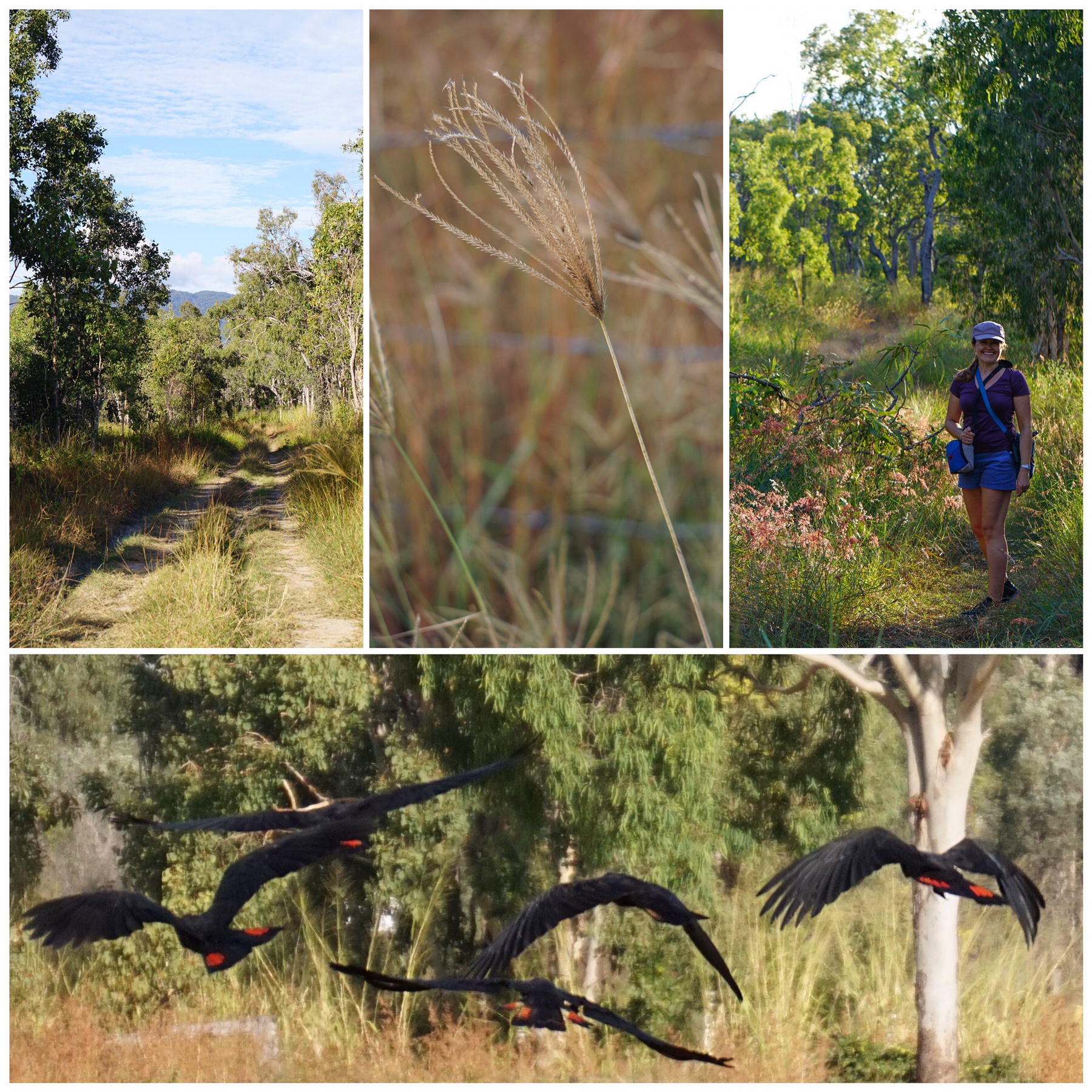
 Even the cattle were beautiful!
Even the cattle were beautiful!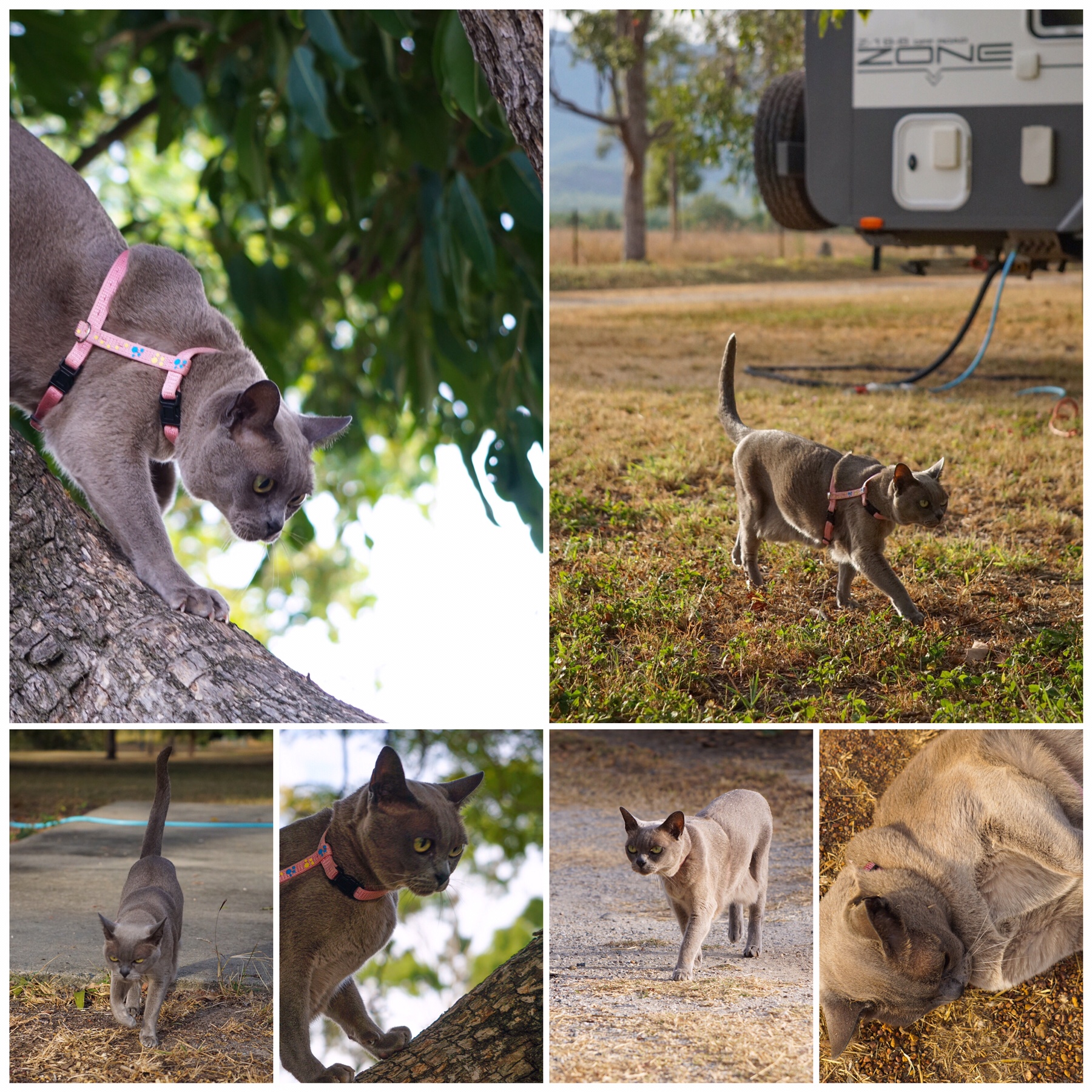 Only one other caravan was there on the whole of the property, well until 6.30 pm when it was pitch black, and we are in full dinner prep mode for a nasi goreng feast, with me wearing a clear plastic glove on one hand as I was cutting up the turmeric (it stains your skin yellow)..and there was knock on the door. I opened to find a lady at the door, another van had pulled up right next to us. They had been delayed on the road after hitting a kangaroo and she was asking me where the camp office was.
Only one other caravan was there on the whole of the property, well until 6.30 pm when it was pitch black, and we are in full dinner prep mode for a nasi goreng feast, with me wearing a clear plastic glove on one hand as I was cutting up the turmeric (it stains your skin yellow)..and there was knock on the door. I opened to find a lady at the door, another van had pulled up right next to us. They had been delayed on the road after hitting a kangaroo and she was asking me where the camp office was.